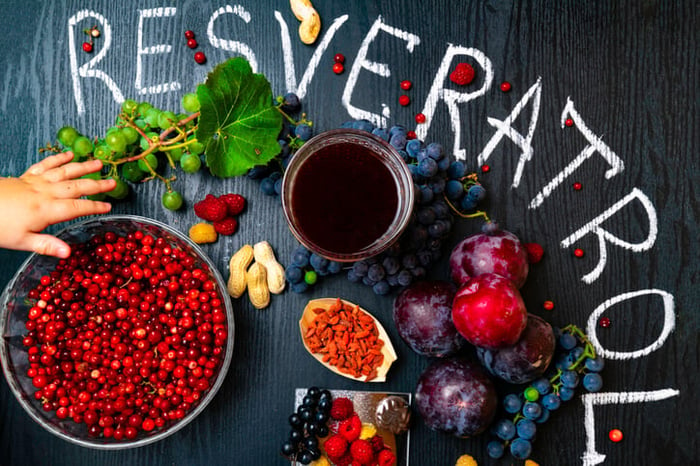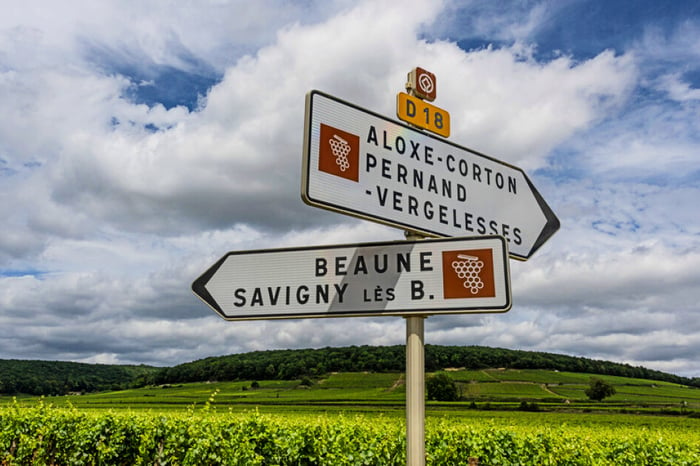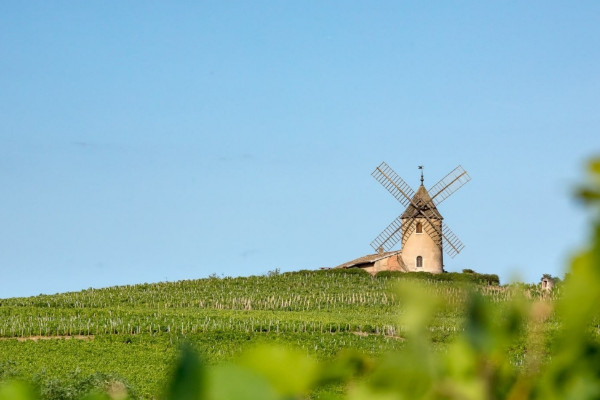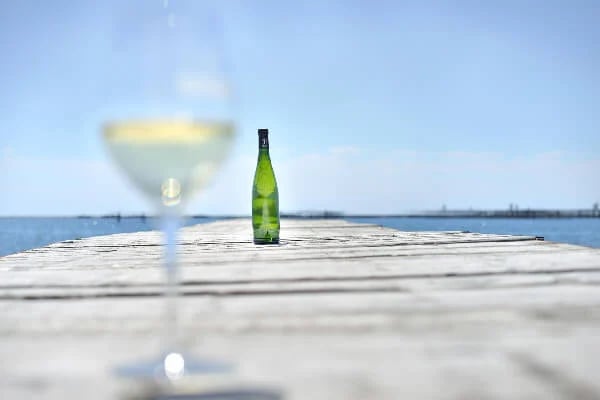
Picpoul de Pinet, Picpoul or Piquepoul?
Picpoul de Pinet, Picpoul or Piquepoul, what's the difference?
It's pretty simple. Picpoul de Pinet is an appellation in the south of France. Picpoul, or Piquepoul, are synonynms for the grape variety.
Read on to discover more...
Picpoul de Pinet "Soleil" 2023, Languedoc

£13.50
Here is a Picpoul de Pinet in a class of its own. Winner of a gold medal at the Concours Général Agricole Paris. The wine...… read more
Picpoul or Piquepoul, the grape
The origins of the Piquepoul name are a little hazy. A popular theory is that chickens ( poules in French) used to “pick” at the grapes that fell to the ground. The literal translation is “hen-pecked”.
It goes by many other names, including Avello, Avillo, Extra, Feher Piquepoul, Languedocien, Picapoll, Picapolla, Picapulla, and Picpoul. The last of which is probably the best known and translates as "lip-stinger".
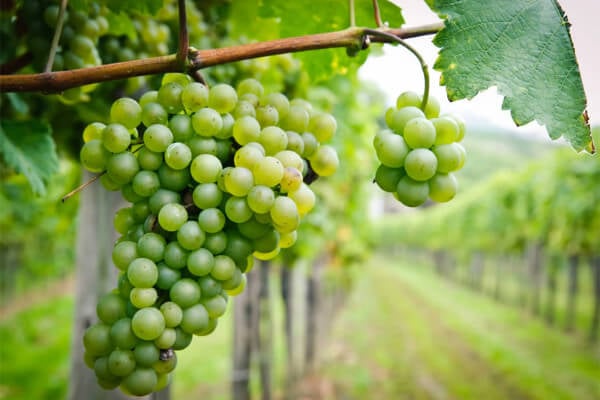 Piquepoul Blanc grapes hanging on the vine
Piquepoul Blanc grapes hanging on the vine
The first written record comes from the 14th century. A medieval estate agent listed Piquepoul Noir in the particulars for a vineyard rental near Toulouse.
Two mutations, Piquepoul gris and the more popular Piquepoul blanc, date from the 19th century. More on which later.
Where does Picpoul grow?
Picpoul is drought resistant, with a long growing cycle. It is well adapted to hot, dry places.
It is, therefore, unsurprising that its home is in southern France and northern Spain.
The largest concentration of vines are in Languedoc, France, most notably in the vineyards of Picpoul de Pinet . It is also one of the grapes permitted in Chateauneuf-du-Pape (though it accounts for less than 1% of the vines planted there).
What does Picpoul taste like?
Typically, Picpoul is elegant, clean and fresh.
It is a thin-skinned grape variety and when mature the skins retain a high level of acidity. This racy acidity gives it a distinctive profile. Young wines express lemon and lime flavours, whilst aged examples tend more towards oranges.
The grapes are late-maturing and so, the harvest rarely starts before mid-September. The extra hang-time allows the grapes to benefit from the late summer sun, cooler evenings, damper nights, and sea mists.
In fact, the influence of the sea is rarely far from the vineyards, with the sea air imparting a welcome saltiness to the best examples.
Other common flavours include stone fruits and Mediterranean herbs such as thyme and sage.
Wines made from Piquepoul Noir are more aromatic. Typically, rosé wines made from Piquepoul Noir have red fruit and flower blossom aromas.
Piquepoul Rosé Foncalieu 2024, Languedoc

£14.50
A pale pink in colour, this Piquepoul rosé has a delicate nose of cherry blossom, strawberries and peaches. The palate is wonderfully fresh with summer...… read more
What food should I pair with Picpoul?
Picpoul pairs perfectly with shellfish and seafood, revealing their textures and flavours brilliantly. The classic pairing is Bouzigues oysters from the Bassin de Thau.
As the old adage has it, "if it grows with it, it goes with it".
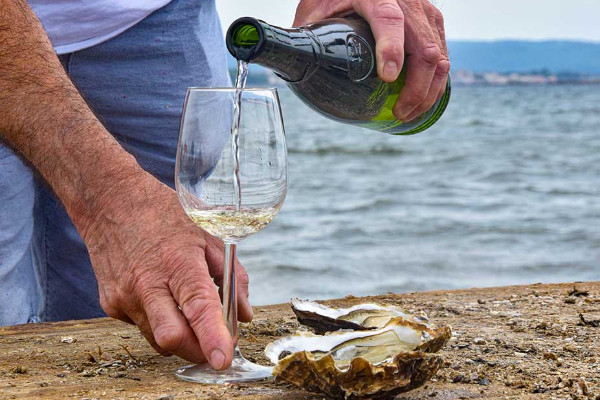 Picpoul served with oysters
Picpoul served with oysters
Complex examples, which may have spent time on their lees, can cope with more gastronomic pairings. Try them with strong mountain cheeses or spicy Asian style foods.
Can I age Picpoul?
Most vignerons make their Picpoul wines to be drunk young. This year's wine will be ready to drink next spring, and it should be drunk within one or two years of release.
There is however, always an exception to every rule...
Patience is a collaboration by the winemakers of Picpoul de Pinet. These are wines which show the ageing potential of the variety.
The grapes used in the Patience wines often come from older vines. They have added structure, texture, and complexity thanks to time spent on the fine lees.
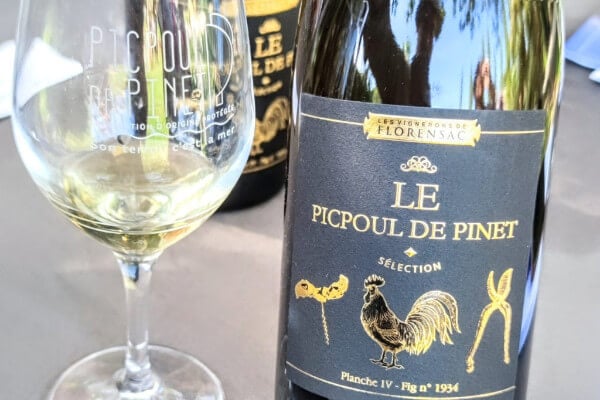 Picpoul Patience from FlorensacIn June 2023 I was lucky to taste two flights of aged Picpoul de Pinet wine spanning the vintages 2016 to 2022. The first flight was from Mas Saint Laurent in Mèze and the second was from Les Vignobles de Florensac.
Picpoul Patience from FlorensacIn June 2023 I was lucky to taste two flights of aged Picpoul de Pinet wine spanning the vintages 2016 to 2022. The first flight was from Mas Saint Laurent in Mèze and the second was from Les Vignobles de Florensac.
All the wines showed typical acidity with a salty, mineral streak.
The colour deepened as they aged, reaching a beautiful golden hue in the oldest wines. What surprised me most was how the savoury side of the variety came forward. Many of the wines showed notes of smoke, bacon rind, marmite, and garrigue herbs.
For committed oenophiles with the patience for Patience there is great ageing potential. I think that even the oldest wines in the tasting would improve with five more years in the cellar. There are only 12 producers making these wines and so they may be difficult to find.
They have their own unique brown glass bottle engraved with the words "Picpoul de Pinet". (As opposed to standard Picpoul de Pinet wines which come in their traditional green Neptune bottle).
Florensac Picpoul de Pinet Selection "Patience" 2022, Languedoc

£19.50
Patience is a new, more gastronomic, style of Picpoul. It is something special for Picpoul lovers in search of the next level. In the glass...… read more
Picpoul de Pinet, the Appellation
Picpoul de Pinet is an Appellation d’Origine Protégée (AOP) in the Languedoc region of France. The appellation is a triangle bounded by the towns of Agde, Pézenas and Sète.
Within sight of the Mediterranean, the vineyards surround the Bassin de Thau lagoon. The appellation tag line is Son terroir c'est la mer, which translates as Our terroir is the sea.
At the centre of the appellation sits the village of Pinet (which is on the left bank of the Hérault river). The vineyards cover five communes in addition to Pinet: Castelnau-de-Guers, Florensac, Mèze, Montagnac, and Pomérols.
History
Vines have been present in the area since Roman times when the Via Domitia crossed the vineyard. The earliest written record to refer to Picapoll comes from 1384. Picapoll nigri was one of several varieties listed in a rental contract for a vineyard near Toulouse.
Some years later, in 1677, a botanist named Pierre Mangol wrote a treaty on the flora of Montpellier. In it, he listed Piquepoul Noir among the Languedoc’s black grape varieties. Contemporary records provide evidence that, from the Pyrenees to the Southern Rhône, it was a commonly planted variety.
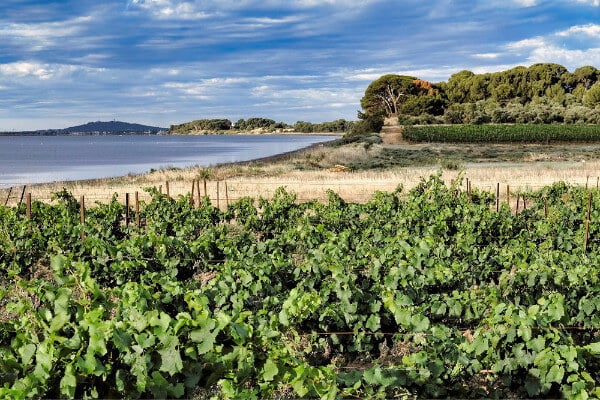 Vineyards surrounding the Bassin de Thau
Vineyards surrounding the Bassin de ThauRemember though, we are talking about Piquepoul Noir. A grape which produces light, aromatic, red wines.
In the 19th century French wine drinkers developed a taste for darker red wines. Winemakers responded to demand by planting more of the fuller-bodied Spanish grape varieties. Varieties we now associate with the region such as Grenache (Garnacha), Carignan (Cariñena) and Mouverdre (Monastrell).
Piquepoul Noir fell from fashion. Looking for alternatives growers began to propagate vines with lighter coloured grapes. This led first to the Piquepoul Gris variant and then to Piquepoul Blanc.
But, interest in wines made from any of the three versions was pretty much non-existent during the 19th century.
At the dawn of the 20th century the reputation of Piquepoul was at rock bottom. It was relegated to a work-horse variety good only for the production of vermouth. (Hence why the headquarters of famous vermouth producer Noilly Prat are in the Hérault département).
Its road to recovery began in the 1920s when the winemakers of Pinet put their heads together. They knew their grapes had potential.
Potential beyond vermouth.
Potential to Zing.
And so, they took the decision to champion dry white wines made from their Piquepoul Blanc grapes.
The decision paid off.
In 1954 the region of Pinet was granted Vin Délimité de Qualité Supérieure (VdQS) status. Then in 1985 it became a sub-region of the AOC Coteaux de Languedoc. It finally gained full AOP status in 2013.
From also-ran to hero in less than 100 years.
The Rules
The French like rules.
As an Appellation d’Origine Protégée (AOP) there must be rules. In Picpoul de Pinet the rules are simple: the wines must be dry, white, and made only from Piquepoul Blanc grapes.
It is uncommon for an appellation to permit only one grape variety, one colour and one style. It is also rare for the appellation and the grape to have such similar names.
Such simple rules are uncharacteristically French, but they may explain why Picpoul de Pinet is popular in the UK. If you see Picpoul on the label you can be pretty sure of what to expect from the wine within.
The Bottle
Picpoul de Pinet is easily identifiable on the shelves thanks to its distinctive Neptune bottle. In a nod to the influence of the ocean the name references the Roman God of the Sea.
The bottles are all made by the Albi glassworks factory. Engraved on each bottle is the name “Picpoul de Pinet”. Just above the name is a stamp of the Languedoc Cross. The final flourish is a wave pattern running around the neck.
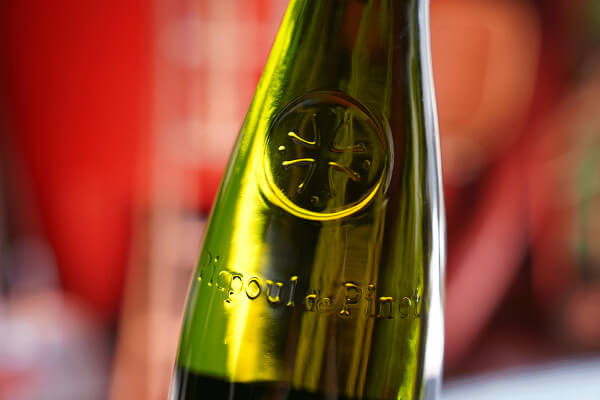 The distinctive Neptune bottle
The distinctive Neptune bottleI hope this quick guide has cleared up any confusion and maybe inspired you to try this delicious, dry, white wine.


